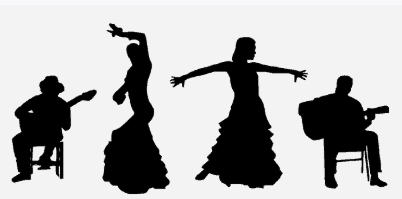Activity of text interpretation, aimed at students in the sixth year of elementary school, about flamenco. Have you ever heard of this typical Spanish dance? How about getting to know her or, if you already know her, knowing more about her? so read the text Flamenco – Spain (Europe)! Then answer the various interpretative questions proposed! Come on?
This reading comprehension activity is available for download in an editable Word template, ready to print in PDF as well as the completed activity.
Download this text interpretation exercise at:
SCHOOL: DATE:
PROF: CLASS:
NAME:
Carefully read the text. Then answer the interpretive questions:
Castanets, ruffled dresses, fans, engaging rhythms, dramatic interpretation… All of this contributes to the strength and intensity of a flamenco performance, a typical Spanish dance. To become what it is today, the style, which in 2010 was elected Intangible Cultural Heritage of Humanity by Unesco (Organization of the United Nations for Education, Science and Culture), was influenced by various peoples, including Gypsies, Arabs and Jews.
But those who think that there is only one type of flamenco are wrong. Over the years, the dance has gone through several modifications and influences, making today there are more than 50 different strands.
Although they have elements in common, the styles have their own characteristics, with specific movements and rhythms. Some of the best known types are: alegrías (one of the oldest), sevillanas (popular with the general public) and soleá (very much practiced by professional artists).
Text fragment: “Learn 5 dance styles around the world”. Available in: .

Question 1 - Identify the purpose of who wrote the text read:
( ) present the flamenco dance.
( ) explain how to dance flamenco.
( ) publicize a flamenco performance.
Question 2 - Reread this passage from the text:
“All of this contributes to the strength and intensity of a flamenco performance, typical dance from spain.”
In this passage, the highlighted excerpt:
( ) evaluates the term “flamenco”.
( ) defines the term “flamenco”.
( ) characterizes the term “flamenco”.
Question 3 - In view of the notion of time presented in the text, check the verb that fills the gap below:
“Gypsies, Arabs and Jews, among other peoples, ________________ the flamenco.”
( ) “influenced”.
( ) “influence”.
( ) “will influence”.
question 4– In the period “But those who think that there is only one type of flamenco are mistaken […]”, the word “only” indicates:
( ) a restriction.
( ) an exclusion.
( ) a condition.
Question 5 - In the segment “Over the years, the dance passed on by various modifications and influences […]", the underlined verb expresses:
( ) a question about flamenco.
( ) a certainty about flamenco.
( ) a hypothesis about flamenco.
Question 6 – In the part “[…] causing, today, exist more than 50 different strands.”, the underlined verb could be replaced by:
( ) “there is”.
( ) “let there be”.
( ) “let there be” or “let there be”.
Question 7 – In the paragraph that closes the text, the verb “present” refers to the subject:
( ) “elements in common”.
( ) “the styles”.
( ) “specific movements and rhythms”.
Question 8 – Point out the type of flamenco that, according to the text, is the most practiced by professional artists:
( ) “joys”.
( ) “sevillanas”.
( ) “soleá”.
Per Denyse Lage Fonseca – Graduated in Languages and specialist in distance education.
At answers are in the link above the header.
 report this ad
report this ad